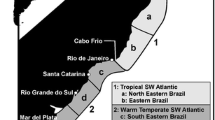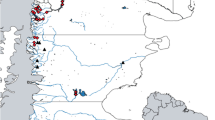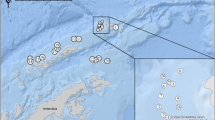Abstract
Parasites, being an integral part of every ecosystem and trophically transmitted along the food webs, can provide detailed insights into the structure of food webs and can close the information gap between short-term stomach content analyses and long-term fish otolith analyses. They are useful for tracking ontogenetic shifts in the host’s diet, the occurrence of specific organisms or migratory behaviour of their hosts, even in inaccessible environments. In the present study, stomach content analyses and parasitological examinations were performed on 70 Atlantic cod Gadus morhua, one of the most important high-level predators of small fish in the North Atlantic, caught during one research vessel cruise from West and East Greenlandic waters. Analyses revealed significant differences in fish size with higher values for East Greenland (average total length (TL) of 50.5 cm) compared to West Greenland (average TL of 33.3 cm). Clear differences were also present in prey and parasite composition. Crustacea was the main food source for all fish (IRI = 10082.70), while the importance of teleosts increased with fish size. With a prevalence of 85 % in West Greenland and 100 % in East Greenland, Nematoda were the most abundant parasite group. The results indicate an ontogenetic shift in the diet, which are discussed in the context of the common distribution theory, stock dynamics and migratory behaviour.



Similar content being viewed by others
References
Altschul SF, Gish W, Miller W, Myers EW, Lipman DJ (1990) Basic local alignment search tool. J Mol Biol 215:403–410
Brander K (2005) Spawning and life history information for North Atlantic cod stocks. ICES Coop Res Rep 274, Copenhagen
Busch MW, Kuhn T, Münster J, Klimpel S (2012) Marine crustanceans as potential hosts and vectors for metazoan parasites. In: Mehlhorn H (ed) Arthropods as vectors of emerging diseases, Parasitol Res Monographs 3. Springer, Berlin, pp 329–360
Bush AO, Lafferty KD, Lotz JA, Shostak AW (1997) Parasitology meets ecology on its own terms: Margolis et al. revisited. J Parasitol 83:575–583
Choisy M, Brown SP, Lafferty KD, Thomas F (2003) Evolution of trophic transmission in parasites: why add intermediate hosts? Am Nat 162:172–181
Cohen DM, Inada T, Iwamoto T, Scialabba N (1990) Gadiform fishes of the world (Order Gadiformes). An annotated and illustrated catalogue of cods, hakes, grenadiers and other gadiform fishes known to date. FAO species catalog, vol 10. FAO Fish Synop 125, Rome
Coltman DW, Stenson G, Hammill MO, Haug C, Davis S, Fulton TL (2007) Panmictic population structure on the hooded seal (Cystophora cristata). Mol Ecol 16:1639–1648
Fahay MP, Berrien PL, Johnson DL, Morse WW (1999) Atlantic cod, Gadus morhua, life history and habitat characteristics. NOAA Technical Memoradum NMFS-NE-124
Froese R, Pauly D (2014) FishBase. http://www.fishbase.org. Accessed 1 June 2014
Heide-Jørgensen MP, Simon MJ, Laidre KL (2007) Estimates of large whale abundance in Greenlandic waters from a ship-based survey in 2005. J Cetac Res Manage 9:95–104
Hemmingsen W, MacKenzie K (2001) The parasite fauna of the Atlantic cod, Gadus morhua L. Adv Mar Biol 40:2–60
Hemmingsen W, Lombardo I, MacKenzie K (1991) Parasites as biological tags for cod, Gadus morhua L., in northern Norway: a pilot study. Fish Res 12:365–373
Hovgård H, Christensen S (1990) Population structure and migration patterns of Atlantic cod (Gadus morhua) in West Greenland waters based on tagging experiments from 1946 to 1964. NAFO Sci Counc Stud 14:45–50
Hyslop EJ (1980) Stomach contents analysis—a review of methods and their application. J Fish Biol 17:411–439
Jennings S, Blanchard JL (2004) Fish abundance with no fishing: predictions based on macroecological theory. J Anim Ecol 73:632–642
Klimpel S, Palm HW (2011) Anisakid nematode (Ascaridoidea) life cycles and distribution: increasing zoonotic potential in the time of climate change? In: Mehlhorn H (ed) Progress in parasitology, Parasitol Res Monographs 2. Springer, Heidelberg, pp 201–222
Klimpel S, Palm HW, Rückert S, Piatkowski U (2004) The life cycle of Anisakis simplex in the Norwegian deep (northern North Sea). Parasitol Res 94:1–9
Klimpel S, Busch MW, Kellermanns E, Kleinertz S, Palm HW (2009) Metazoan deep-sea fish parasites. Acta Biologica Benrodis, Supplementband 11. Verlag Natur & Wissenschaft, Solingen
Køie M (1983) Digenetic trematodes from Limanda limanda (L.) (Osteichthyes, Pleuronectidae) from Danish and adjacent waters, with special reference to their life histories. Ophelia 22:201–228
Kuhn T, García-Màrquez J, Klimpel S (2011) Adaptive radiation within marine anisakid nematodes: a zoogeographical modelling of cosmopolitan, zoonotic parasites. PLoS One 6, e28642. doi:10.1371/journal.pone.0028642
Kuhn T, Benninghoff T, Karl H, Landry T, Klimpel S (2013) Sealworm Pseudoterranova decipiens s.s. infection of European smelt Osmerus eperlanus in German coastal waters: ecological implications. Dis Aquat Org 102:217–224
Link JS, Garrison LP (2002) Trophic ecology of Atlantic cod Gadus morhua on the northeast US continental shelf. Mar Ecol Prog Ser 227:109–123
MacKenzie K, Campbell N, Mattiucci S, Ramos P, Pinto AL, Abaunza P (2008) Parasites as biological tags for stock identification of Atlantic horse mackerel Trachurus trachurus L. Fish Res 89:136–145
Mattiucci S, Cipriani P, Webb SC, Paoletti SC, Marcer F, Bellisario B, Gibson DI, Nascetti G (2014) Genetic and morphological approaches distinguish the three sibling species of the Anisakis simplex complex, with a special designation as Anisakis berlandi n. sp. For A. simplex sp. C (Nematoda: Anisakidae). J Parasitol 100:199–214
Mattiuci S, Nascetti G (2008) Advances and trends in the molecular systematics of anisakid nematodes, with implications for their evolutionary ecology and the host-parasite co-evolutionary processes. Adv Parasit 66:47–148
Mouritsen KN, Hederholm R, Schack HB, Møller LN, Storr-Paulsen M, Dzido J, Rockicki J (2010) Occurrence of anisakid nematodes in Atlantic cod (Gadus morhua) and Greenland cod (Gadus ogac) West Greenland. Acta Parasitol 55:81–89
Nadler SA, Hudspeth DSS (2000) Phylogeny of the Ascaridoidea (Nematoda: Ascaridida) based on three genes and morphology: hypotheses of structural and sequence evolution. J Parasitol 86:380–393
Parker GA, Chubb JC, Ball MA, Roberts GN (2003) Evolution of complex life cycle in helminth parasites. Nature 425:480–484
Pinkas L, Oliphant MS, Iverson ILK (1971) Food habits of albacorere, bluefin tuna, and bonito in California waters. Calif Fish Game 152:1–105
Platt NE (1976) Infestation of cod (Gadus morhua L.) with larvae of codworm (Terranova decipiens Krabbe) and heringworm, Anisakis sp. (Nematoda Ascaridata), in North Atlantic and Arctic waters. J Appl Ecol 12:437–450
Rätz H-J (1994) Assessment of the migration of Atlantic cod (Gadus morhua L.) between the stocks off West and East Greenland in 1984–86 by means of otolith typing. J Northwest Atl Fish Sci 16:7–18
Robichaud D, Rose GA (2004) Migratory behaviour and range in Atlantic cod: inference from a century of tagging. Fish Fish 5:185–214
Schopka SA (1993) The Greenland cod (Gadus morhua) at Iceland 1941–90 and their impact on assessments. NAFO Sci Coun Stud 18:81–85
Storr-Paulsen M, Wieland K, Hovgård H, Rätz H-J (2004) Stockstructure of Atlantic cod (Gadus morhua) in West Greenland waters: implications of transport and migration. J Mar Sci 61:972–982
Strømes E, Andersen K (1998) Distribution of whaleworm (Anisakis simplex, Nematoda, Ascaridoidea) L3 larvae in three species of marine fish; saithe (Pollachius virens (L.)), cod (Gadus morhua L.) and redfish (Sebastes marinus (L.)) from Norwegian waters. Parasitol Res 84:281–285
Washington HG (1984) Diversity, biotic and similarity indices: a review with special relevance to aquatic ecosystems. Water Res 18:653–694
Wieland K, Hovgård H (2002) Distribution and drift of Atkantic cod (Gadus morhua) eggs and larvae in Greenland offshore waters. J Northwest Atl Fish Sci 30:61–76
Wieland K, Storr-Paulsen M (2005) East and West Greenland. In: Brander K (ed) Spawning and life history information for North Atlantic cod stocks. ICES Coop Res Rep 274:39–47
Williams HH, MacKenzie K, McCarthy AM (1992) Parasites as biological indicators of the population biology, migrations, diet, and phylogenetics of fish. Rev Fish Biol Fisher 2:144–176
Zhu X, D’Amelio S, Paggi L, Gasser RB (2000) Assessing sequence variation in the internal transcribed spacers of ribosomal DNA within and among members of the Contracaecum osculatum complex (Nematoda: Ascaridoidea: Anisakidae). Parasitol Res 86:677–683
Acknowledgments
We would like to thank Dr. R Bray for the identification of digenean specimens and Prof. Dr. C. Bridges for supervising the preceded study. The study was financially supported by the research funding programme “Landes-Offensive zur Entwicklung Wissenschaftlich-ökonomischer Exzellenz (LOEWE)” of Hesse’s Ministry of Higher Education, Research, and the Arts and the Ichthyological Association (GFI).
Conflict of interest
The authors declare that they have no conflict of interest.
Author information
Authors and Affiliations
Corresponding author
Rights and permissions
About this article
Cite this article
Münster, J., Klimpel, S., Fock, H.O. et al. Parasites as biological tags to track an ontogenetic shift in the feeding behaviour of Gadus morhua off West and East Greenland. Parasitol Res 114, 2723–2733 (2015). https://doi.org/10.1007/s00436-015-4479-y
Received:
Accepted:
Published:
Issue Date:
DOI: https://doi.org/10.1007/s00436-015-4479-y




